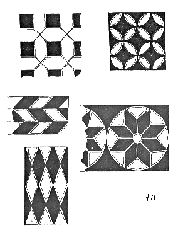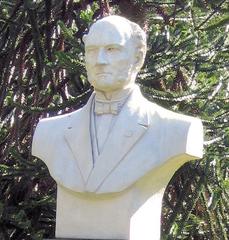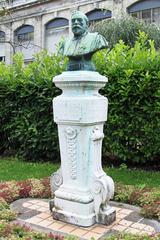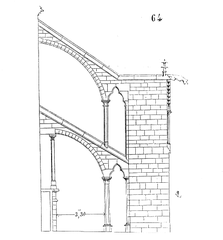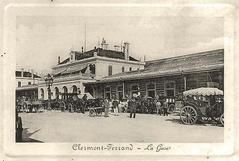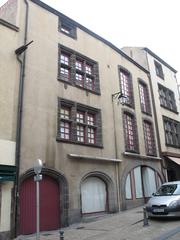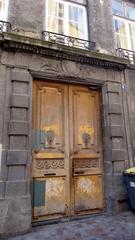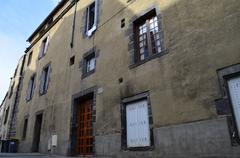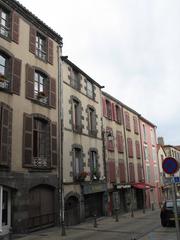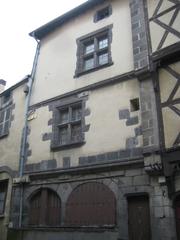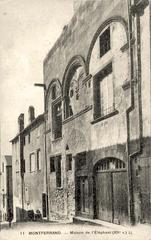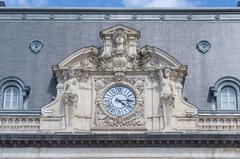
Temple de Vasso Galate: Visiting Hours, Tickets, and Guide to Clermont-Ferrand’s Historical Sites
Date: 04/07/2025
Introduction
Nestled in the heart of Clermont-Ferrand, the Temple de Vasso Galate stands as a testament to the city’s rich historical and cultural evolution. Known for its evocative “Mur des Sarrasins,” this Gallo-Roman archaeological site offers a unique window into Clermont-Ferrand’s ancient past. The temple’s enigmatic origins, architectural remnants, and role in the city’s religious identity make it a compelling site for history enthusiasts and travelers alike. This guide provides all the practical information you need—visiting hours, ticketing, accessibility, and nearby attractions—alongside historical context to ensure a rewarding and informed visit (Wikipedia, Clermont Auvergne Volcans).
Origins and Historical Context
Dating to the 2nd century CE, during the Roman High Empire, the Temple de Vasso Galate was constructed in Augustonemetum, the ancient precursor to modern Clermont-Ferrand. The site’s name, recorded by Gregory of Tours in the 6th century, suggests a blending of local Gallic and Roman religious traditions—possibly associated with the worship of Mercury, the god of commerce and travelers (Wikipedia). The temple’s destruction during barbarian invasions in the early 5th century, as chronicled by Gregory, underscores its significance in the city’s history (Augustonemetum.fr).
Archaeological and Architectural Description
The most prominent remnant of the temple is the northern wall, or “Mur des Sarrasins,” located between rue Rameau and rue Bonnabaud. This Gallo-Roman structure, preserved in elevation, provides rare architectural insights. Gregory of Tours described the temple as a massive edifice with double walls approximately 8.8 meters thick, lavishly decorated inside with marble and mosaics, and topped by a lead roof (Wikipedia, Aroundus). Though only portions survive, the temple’s remains are a centerpiece of Clermont-Ferrand’s archaeological heritage.
Religious and Civic Significance
While scholars debate the precise deity honored here, the temple is widely believed to have been dedicated to Mercury, reflecting its civic and religious importance (Wikipedia). The site symbolizes not only the spiritual life of ancient Augustonemetum but also the city’s prosperity and its integration into Roman Gaul.
Visiting the Temple de Vasso Galate: Practical Information
Visiting Hours and Entry
The Temple de Vasso Galate is situated on private property and is generally not open for daily public access. However, it is periodically accessible during special events such as the Journées Européennes du Patrimoine (European Heritage Days), usually held in September. During these occasions, visitors can explore the site, often free of charge, though advance registration may be required due to limited capacity.
For the most accurate and current visiting hours, consult the official Clermont-Ferrand tourism website or contact the local heritage office directly. Outside of special events, the temple can often be viewed externally from public streets.
Accessibility
Access to the site is limited due to its urban setting. The surrounding sidewalks are mostly accessible for visitors with reduced mobility, but interior access during special openings may involve uneven ground or steps. It’s recommended to inquire in advance about accessibility accommodations.
Guided Tours and Special Events
Guided tours are occasionally organized, particularly during heritage events or as part of archaeological circuits in Clermont-Ferrand. The tourism office and local tour operators can provide schedules and booking information. The temple is frequently included in broader heritage walks alongside sites such as the Cathédrale Notre-Dame-de-l’Assomption and the Basilica of Notre-Dame du Port (Clermont Auvergne Volcans).
Nearby Attractions
Enhance your visit by exploring these nearby sites:
- Cathédrale Notre-Dame-de-l’Assomption: A monumental Gothic cathedral built from black volcanic stone, dominating the city skyline.
- Basilica of Notre-Dame du Port: A UNESCO-listed Romanesque basilica renowned for its sculpture and mosaics.
- Place de Jaude: The city’s lively central square.
- Temple of Mercury at Puy de Dôme: The remains of another important Roman sanctuary, accessible via a scenic train ride (Wikipedia).
Additional recommendations include the Musée d’Art Roger Quilliot and the historic district of Montferrand.
Frequently Asked Questions (FAQ)
Q: Can I visit the Temple de Vasso Galate year-round?
A: Regular access is not available year-round; visits are generally limited to special heritage events. The exterior can be viewed from the street at any time.
Q: Is there an entrance fee?
A: Admission during heritage events is typically free, but some events may require advance registration.
Q: Is the temple accessible for visitors with disabilities?
A: The site’s urban surroundings are mostly accessible, but interior areas may have uneven terrain.
Q: Are guided tours available?
A: Yes, but only during special events or as part of local heritage tours. Check with the Clermont-Ferrand tourism office for details.
Q: What other sites should I visit nearby?
A: The Cathédrale Notre-Dame-de-l’Assomption, Basilica of Notre-Dame du Port, Place de Jaude, and the Temple of Mercury at Puy de Dôme.
Preservation and Legacy
The Temple de Vasso Galate has been classified as a Monument Historique since 1889, highlighting its importance in France’s national heritage (Monumentum). Ongoing preservation efforts ensure that this rare relic of the ancient city continues to inform and inspire visitors.
Planning Your Visit & Staying Connected
For the latest information on opening hours, tours, and events, consult the Clermont Auvergne Volcans Tourism Office. Download the Audiala mobile app for up-to-date notifications, interactive maps, and exclusive audio guides. For heritage events such as the Journées Européennes du Patrimoine, check local cultural calendars (JDS Clermont-Ferrand).
Image and Map Resources
- Interactive maps are available via Mapcarta.
Summary
The Temple de Vasso Galate is a must-see for those interested in Clermont-Ferrand’s ancient past. Its monumental wall, rich historical associations, and proximity to other major sites make it a rewarding highlight of the city’s heritage trail. Plan your visit for special openings, explore the city’s other Roman and medieval landmarks, and immerse yourself in the layers of history that define Clermont-Ferrand.
Sources and Further Reading
- Wikipedia
- Clermont Auvergne Volcans
- Monumentum
- Mapcarta
- JDS Clermont-Ferrand
- Aroundus
- France This Way
- The Crazy Tourist
- Augustonemetum.fr
- Tourist Places Guide

